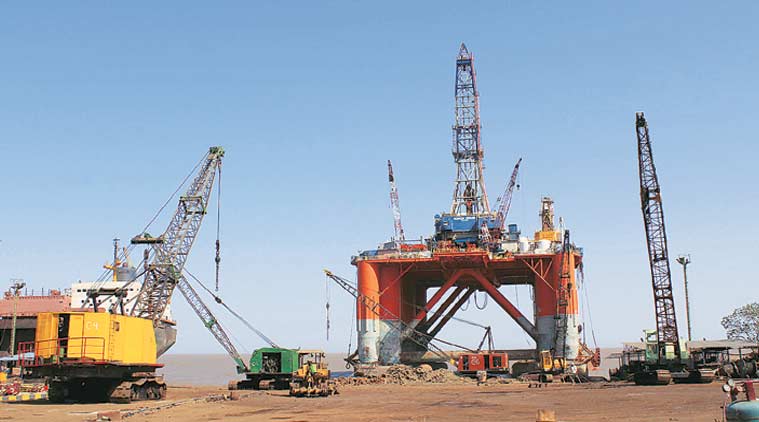 Sonya Venus reached Alang from Sakhalin in Russia. (Photo: Javed Raja)
Sonya Venus reached Alang from Sakhalin in Russia. (Photo: Javed Raja)
SAMIR BHAYANI is busy monitoring work at his bustling yard, where workers have just finished beaching a 43-year-old oil rig from the Sakhalin fields in Russia. This is the first rig that Bhayani will be dismantling in his 30 years as a ship-breaker in Gujarat’s Alang.
“The rig beached 4,000 metres away in the sea and we spent almost 60 days trying to pull it closer to the beach for dismantling,” says Bhayani about the orange-coloured, eight-legged Sonya Venus, weighing 13,000 LDT (Light Displacement Tonnage).
Over the last year, it’s not just ships that are being dismantled in Alang. According to ship-breakers here, dipping crude oil prices worldwide and rising iron prices in India are attracting “idle oil rigs” to this ship-breaking hub.
Gujarat Maritime Board (GMB) data shows that from April 2017 to March 2018, 61 of the 253 vessels that reached Alang were oil tankers and rigs.
Between January and March 2018, 30 of the 87 vessels that arrived to be recycled were tankers and rigs, over one-third of the total. In March, they constituted 12 of the 25 vessels — nearly half — that docked in Alang. In April, seven of the 16 vessels that arrived were oil rigs or oil tankers.
“When crude oil dipped to US$40 per barrel, there were a lot of oil rigs that were lying idle. As the oil prices went down, the price of iron improved in India and so it became viable to bring some of these idle rigs to be broken. There has been a continuous flow of oil rigs to Alang and it is still continuing,” says Haresh Parmar, a ship-breaker at Alang and honorary joint secretary of Ship Recycling Industries Association (SRIA).
These rigs are largely from South America and South Asia, say ship-breakers. “Apart from poor sentiments in the oil market, one of the major reasons for oil tankers to head to Alang is the ban imposed by Pakistan on scrapping oil and LPG tankers after a string of accidents last year at the Gadani yard. All tankers for recycling are being diverted to India. Our safety norms are stringent and tankers have to be cleaned before being beached for recycling,” says Parmar.
In September 2013, crude oil price was around $110 per barrel and fell steadily thereafter till February 2016, when it hit a low of around $30 per barrel. Thereafter, the price has gone up and is currently over $70 a barrel.
Gujarat government officials monitoring ship-breaking activities at Alang agree that a slump in the oil market over the last two years has pushed more owners to scrap their ageing tankers and rigs. “There has been a phenomenally high number of oil rigs and tankers that are coming to be broken at Alang. We have never seen such influx in the past,” says Captain Sudhir Chaddha, a port officer from the GMB, who has been in-charge of the Alang ship-breaking yard since 2010.
This influx has seen a number of ship-breakers trying their hand at dismantling a rig. Currently, scrap steel from Alang fetches Rs 32,000 per tonne, while the price in 2015 stood at Rs 20,398 per tonne. Ship recycling produces scrap steel and iron, which gets converted into bars, rods or machinery parts.
First-timers like Bhayani say dismantling an oil rig is “safer” than breaking a cargo vessel. “Dismantling an oil rig is a year-long project. However, the gains are far superior. The steel quality of an oil rig is better and we get good returns for the machinery and spare parts. These days, a number of foreign and Indian rig operators source the spare parts and machinery for functional rigs from Alang. It is a cheaper option for them,” says Bhayani.
Shantamani Enterprises is another ship-breaking company at Alang that is trying its hand at dismantling oil rigs “for the first time”. “We are not engineers, but we have taken the help of those who have dismantled a rig earlier. The process involved in breaking an oil rig is very different,” says Chirag Patel, a manager at Shantamani.
Patel is busy monitoring activities onboard “Paragon RIG 161”, a four-legged oil rig that beached at plot number 27 on April 14. “Compared to cutting a cargo vessel, we have to be more careful. Most of it is dismantled and not broken. We do not want to damage the machinery and the spare parts. As these oil platforms operate in high seas, they contain a lot of spare parts. Secondly, there is a lot of demand from rig operators for generator sets, cranes, blowout preventers, mud pumps and other types of machinery from these rigs,” he says.